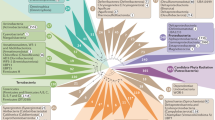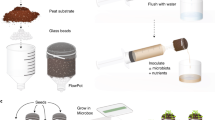Abstract
Most microbial species remain uncultivated, and modifying artificial nutrient media brings only an incremental increase in cultivability. We reasoned that an alternative way to cultivate species with unknown requirements is to use naturally occurring combinations of growth factors. To achieve this, we moved cultivation into the microbes' natural habitat by placing cells taken from varying environmental samples into diffusion chambers, which are then returned to nature for incubation. By miniaturizing the chambers and placing only one to several cells into each chamber, we can grow and isolate microorganisms in axenic culture in one step. We call this cultivation platform the 'isolation chip', or 'ichip'. This platform has been shown to increase microbial recovery from 5- to 300-fold, depending on the study. Furthermore, it provides access to a unique set of microbes that are inaccessible by standard cultivation. Here we provide a simple protocol for building and applying ichips for environmental cultivation of soil bacteria as an example; the protocol consists of (i) preparing the ichip; (ii) collecting an environmental sample; (iii) serially diluting cells and loading them into the ichip; (iv) returning the ichip to the environment for incubation; (v) retrieving the ichip and harvesting grown material; and (vi) domestication of the ichip-derived colonies for growth in the laboratory. The ichip's full assembly and deployment is a relatively simple procedure that, with experience, takes ∼2–3 h. After in situ incubation, retrieval of the ichip and processing of its contents will take ∼1–4 h, depending on which specific procedures are used.
This is a preview of subscription content, access via your institution
Access options
Access Nature and 54 other Nature Portfolio journals
Get Nature+, our best-value online-access subscription
$29.99 / 30 days
cancel any time
Subscribe to this journal
Receive 12 print issues and online access
$259.00 per year
only $21.58 per issue
Buy this article
- Purchase on Springer Link
- Instant access to full article PDF
Prices may be subject to local taxes which are calculated during checkout







Similar content being viewed by others
References
Staley, J.T. & Konopka, A. Measurement of in situ activities of nonphotosynthetic microorganisms in aquatic and terrestrial habitats. Annu. Rev. Microbiol. 39, 321–346 (1985).
Rappe, M.S. & Giovannoni, S.J. The uncultured microbial majority. Annu. Rev. Microbiol. 57, 369–394 (2003).
Epstein, S.S. The phenomenon of microbial uncultivability. Curr. Opin. Microbiol. 16, 636–642 (2013).
Brown, H.P. et al. Culturing of 'unculturable' human microbiota reveals novel taxa and extensive sporulation. Nature 533, 543–546 (2016).
Lagier, J.-C. et al. Culture of previously uncultured members of the human gut microbiota by culturomics. Nat. Microbiol. 1, 16203 (2016).
Hurst, C.J. Divining the future of microbiology. ASM News 71, 262–263 (2005).
Lewis, K., Epstein, S., D'Onofrio, A. & Ling, L.L. Uncultured microorganisms as a source of secondary metabolites. J. Antibiot. 63, 468–476 (2010).
Kaeberlein, T., Lewis, K. & Epstein, S. Isolating 'uncultivable' microorganisms in pure culture in a simulated natural environment. Science 296, 1127–1129 (2002).
Bollmann, A., Lewis, K. & Epstein, S.S. Incubation of environmental samples in a diffusion chamber increases the diversity of recovered isolates. Appl. Environ. Microbiol. 73, 6386–6390 (2007).
Bollmann, A., Palumbo, A.V., Lewis, K. & Epstein, S.S. Isolation and physiology of bacteria from contaminated subsurface sediments. Appl. Eviron. Microbiol. 76, 7413–7419 (2010).
Ben-Dov, E., Kramarsky-Winter, E. & Kushmaro, A. An in situ method for cultivating microorganisms using a double encapsulation technique. FEMS Microbiol. Ecol. 68, 363–371 (2009).
Aoi, C. et al. Hollow-fiber membrane chamber as a device for in situ environmental cultivation. Appl. Environ. Microbiol. 75, 3826–3833 (2009).
Ling, L.L. et al. A new antibiotic kills pathogens without detectable resistance. Nature 517, 455–459 (2015).
Nichols, D. et al. Use of Ichip for high-throughput in situ cultivation of 'uncultivable' microbial species. Appl. Environ. Microbiol. 76, 2445–2450 (2010).
Sizova, M.V. et al. New approaches for isolation of previously uncultivated oral bacteria. Appl. Environ. Microbiol. 78, 194–203 (2012).
Epstein, S.S. & Rossel, J. Enumeration of sandy sediment bacteria: search for optimal protocol. Mar. Ecol. Prog. Ser. 117, 289–298 (1995).
Epstein, S.S. et al. Enumeration of sandy sediment bacteria: are the counts quantitative or relative? Mar. Ecol. Prog. Ser. 151, 11–16 (1997).
Nichols, D. et al. Short peptide induces an 'uncultivable' microorganism to grow in vitro. Appl. Environ. Microbiol. 74, 4889–4897 (2008).
Epstein, S.S. General model of microbial uncultivability. in: Uncultivated Microorganisms. (ed. Epstein, S.S.), Series: Microbiology Monographs Vol. 10 (Series ed. Steinbuchel, A.) 131–150 (Springer, 2009).
Porter, K.G. & Feig, Y.C. The use of DAPI for identifying and counting aquatic microflora. Limnol. Oceanogr. 25, 943–948 (1980).
Epstein, S.S., Lewis, K., Nichols, D. & Gavrish, E. New approaches to microbial isolation. in: Manual of Industrial Microbiology and Biotechnology, (eds. Baltz, R.H., Demain, A.L., and Davies, J.E.) 3–12 (ASM, 2010).
Acknowledgements
Development and application of the ichip was supported by, in chronological order, NSF Grant OCE-0221267 to S.E.; DOE Grant DE-FG02-04ER63782 to K. Lewis (Northeastern University) and S.E.; NIH Grant R21 DE018026-01A1, DOE Grants DE-FG02-07ER64507 and DE-FG02-04ER63782, NIH Grant 1RC1DE020707-01 (all to S.E.); NIH Grant 1R01HG005816-01 to D. Fredricks (Fred Hutchinson Cancer Research Center) and S.E.; NIH Grant AI085612 to A.L.S.; and NSF Grant ARC-1203857 to S.E. We are grateful to J. Case for video production and editing, and C. Williams and A. Eilers for assistance with lab work for protocol troubleshooting and useful discussions.
Author information
Authors and Affiliations
Contributions
S.E. conceived the ichip idea and developed its prototypes. A.L.S., L.L.L., and S.E. simplified and improved the original designs. B.B., A.L.S., and L.L.L. designed and executed growth experiments. All authors wrote the paper.
Corresponding author
Ethics declarations
Competing interests
The ichip technology has been patented by Northeastern University and licensed exclusively to NovoBiotic Pharmaceuticals, LLC.
Supplementary information
Example of an ichip experimental setup.
This video walks through the basic setup of an ichip experiment with soil, beginning with membrane application and continuing through colony visualization. Video production: Joe Case. (MP4 28557 kb)
Rights and permissions
About this article
Cite this article
Berdy, B., Spoering, A., Ling, L. et al. In situ cultivation of previously uncultivable microorganisms using the ichip. Nat Protoc 12, 2232–2242 (2017). https://doi.org/10.1038/nprot.2017.074
Published:
Issue Date:
DOI: https://doi.org/10.1038/nprot.2017.074
This article is cited by
-
Unveiling the bioactive potential of Actinomycetota from the Tagus River estuary
International Microbiology (2024)
-
Use of modified ichip for the cultivation of thermo-tolerant microorganisms from the hot spring
BMC Microbiology (2023)
-
Functional gene-guided enrichment plus in situ microsphere cultivation enables isolation of new crucial ureolytic bacteria from the rumen of cattle
Microbiome (2023)
-
Application of culturomics in fungal isolation from mangrove sediments
Microbiome (2023)
-
Metabolic exchanges are ubiquitous in natural microbial communities
Nature Microbiology (2023)
Comments
By submitting a comment you agree to abide by our Terms and Community Guidelines. If you find something abusive or that does not comply with our terms or guidelines please flag it as inappropriate.



